HIKING HAPPENINGS September 2015
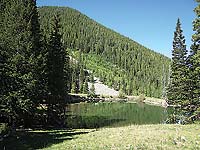 After bouncing along at a snail’s pace on a steep, narrow road for three tedious miles, we have arrived at the Miners Basin parking area where the sudden lack of momentum feels amazingly good. At an elevation of 9300 feet I take a deep breath of cool, pine-scented air, and steady myself on rubbery legs as I stretch to work out the kinks. I’ve been here numerous times and it all looks familiar: the stream-fed pond, the gently swaying aspens, the inviting flower-filled meadow and the northern range of the La Sal Mountains that cradle this basin in three directions. After bouncing along at a snail’s pace on a steep, narrow road for three tedious miles, we have arrived at the Miners Basin parking area where the sudden lack of momentum feels amazingly good. At an elevation of 9300 feet I take a deep breath of cool, pine-scented air, and steady myself on rubbery legs as I stretch to work out the kinks. I’ve been here numerous times and it all looks familiar: the stream-fed pond, the gently swaying aspens, the inviting flower-filled meadow and the northern range of the La Sal Mountains that cradle this basin in three directions. To get to Miners Basin, drive almost eight miles south from the center of town on Highway 191, and take a left turn at the Ken’s Lake-LaSal Loop sign. Then take a right at the “T” intersection. This will put you on Spanish Valley Drive, which quickly becomes the La Sal Loop Road. You will drive by the Geyser Pass, Oowah Lake and Warner Lake Road turn-offs before you get to the sign for Miners Basin, which is approximately 20 miles from the “T” intersection. 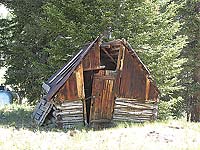 If I could climb into a time machine and zoom back 126 years to Miners Basin, I’d be landing at a rip roaring mining town with 27 brand new cabins and an exploding population, twelve of them being women – back to an era when I could load up on supplies at a grocery store, have a drink at one of the two saloons, go out to dinner with two restaurants to choose from and spend the night at a hotel. This bustling town also had a boarding house where dances were held, a livery and feed stable, shoemaker’s shop, mining office, deputy sheriff, post office and a Sunday School. If I could climb into a time machine and zoom back 126 years to Miners Basin, I’d be landing at a rip roaring mining town with 27 brand new cabins and an exploding population, twelve of them being women – back to an era when I could load up on supplies at a grocery store, have a drink at one of the two saloons, go out to dinner with two restaurants to choose from and spend the night at a hotel. This bustling town also had a boarding house where dances were held, a livery and feed stable, shoemaker’s shop, mining office, deputy sheriff, post office and a Sunday School. Only a few buildings have survived the ravages of a century of neglect in what was known back then as “The Basin,” but enough remains to spark the imagination of times gone by. The miner’s dreams of getting rich, however, faded fast. The gold discovered in 1897 turned out to be a low-grade ore and with an economic downturn in 1907 boom turned to bust. By 1910 probably less than a dozen people remained. The town itself was located about a half mile above the parking lot, but the mines spiraled out in all directions. Even on the most treacherous terrain the evidence is still there of miners staking and working their claims including a rare boiler used to power a steam engine, and on this idyllic alpine summer day I am determined to find it. 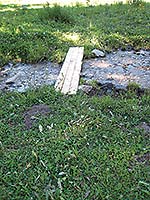 Starting my search I take the trail directly to the left of the National Forest billboard through a meadow chock full of showy daisies – a delightful splash of lavender flowers. At the sign for the Mountain View Trail and Warner Lake I go right. Crossing a tiny bridge over a barely trickling stream, I continue along the trail – an old mining road – until I reach a red gate. So far, so good but after another two tenths of a mile, it gets sketchy. I’ve been told that an other mining road to the left should be close by, so where is it? The search is on - and then - ah ha, I have finally found it concealed within a jumbled pile of downed trees. Starting my search I take the trail directly to the left of the National Forest billboard through a meadow chock full of showy daisies – a delightful splash of lavender flowers. At the sign for the Mountain View Trail and Warner Lake I go right. Crossing a tiny bridge over a barely trickling stream, I continue along the trail – an old mining road – until I reach a red gate. So far, so good but after another two tenths of a mile, it gets sketchy. I’ve been told that an other mining road to the left should be close by, so where is it? The search is on - and then - ah ha, I have finally found it concealed within a jumbled pile of downed trees. Skirting around the barrier of trees a tantalizing moist meadow awaits me – more showy daisies, blue flax, the gentle nod of the bluebell, hairy golden asters, the rich purple of the larkspur and the subtle beauty of the creamy geranium. Wetness makes the footing slippery, but in this enticing paradise, who cares? It’s the perfect excuse to slow down and savor the riches. Over the years this road has been reclaimed by nature, but by drifting to the left I quickly return to it. Now the walking is easier as it leads me to the edges of more meadows mixed with the inviting shade of the aspens and firs. 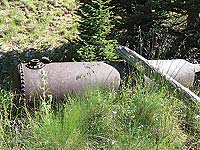 Even when the road completely disappears I can still pick out the most obvious route until at the first switchback it is readily apparent again. Now at an elevation of 10,740 feet, I start my treasure hunt for the boiler, and after some scrambling around – Eureka! – there it is lying on its side above the switchback. Nearby is a cement foundation with metal bars protruding from its base, and some old pieces of sheet metal and weather-beaten wooden beams. What a fascinating piece of history I have stumbled across! Even when the road completely disappears I can still pick out the most obvious route until at the first switchback it is readily apparent again. Now at an elevation of 10,740 feet, I start my treasure hunt for the boiler, and after some scrambling around – Eureka! – there it is lying on its side above the switchback. Nearby is a cement foundation with metal bars protruding from its base, and some old pieces of sheet metal and weather-beaten wooden beams. What a fascinating piece of history I have stumbled across!Having accomplished my goal I am ready for a break - comfortably relaxed I scan the landscape searching for the rest of the road. Zooming in on it I am astounded by its zigzagging course over a steep slope of unstable rocky talus – a route that ends on the ridge between Green and Pilot Peaks! 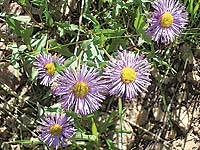 Enjoying a refreshing breeze in the shade of a fir tree I relish the golden solitude. My mind drifts back to times gone by when mining was king in this alpine wilderness, back when this was a busy, noisy place – the roaring machinery, the throbbing steam engine, the racket of digging and loading the ore, shouting voices, etc. And then at the end of a miner’s exhausting day, as darkness sets in, gradually silence returns. Enjoying a refreshing breeze in the shade of a fir tree I relish the golden solitude. My mind drifts back to times gone by when mining was king in this alpine wilderness, back when this was a busy, noisy place – the roaring machinery, the throbbing steam engine, the racket of digging and loading the ore, shouting voices, etc. And then at the end of a miner’s exhausting day, as darkness sets in, gradually silence returns. Things always change, and this way of life didn’t last long. Bit by bit the evidence of the mining heyday disappears. As I ponder the past, I also cherish this feeling of living in the present moment – a day crammed full with wildflowers – a cooling refuge from the desert heat – the pleasurable sound of nuthatches and chickadees – the quarrelsome chatter of squirrels and the earthy scent of mint and pine. These treasures – the intrigue of the past and the current peaceful beauty of the high country – have been worth the rough drive in to Miners Basin. |